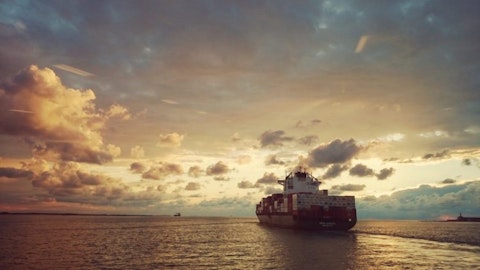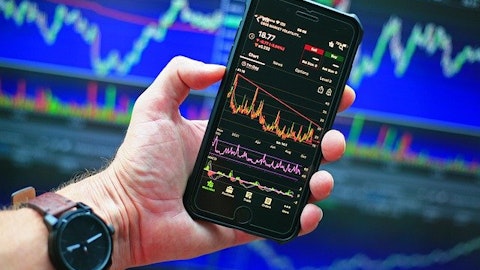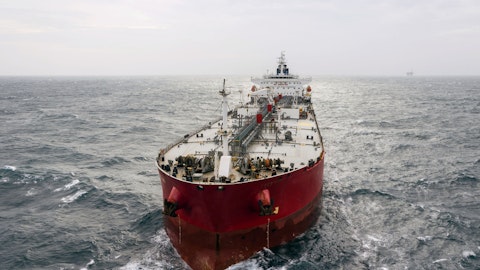Frontline Ltd. (NYSE:FRO) Q3 2022 Earnings Call Transcript November 30, 2022
Frontline Ltd. misses on earnings expectations. Reported EPS is $0.37 EPS, expectations were $0.47.
Operator: Good day. And thank you for standing by. Welcome to the Q3 2022 Frontline Limited Earnings Conference Call. At this time, all participants are in a listen only mode. After the speakers’ presentation, there’ll be a question-and-answer session. Please be advised that today’s conference is being recorded. I would now like to turn the conference over to your speaker today, CEO, Mr. Lars Barstad. Please go ahead.
Lars Barstad: Thank you very much. Good morning and good afternoon to you all. Welcome to Frontline’s third quarter earnings call. It’s quite gratifying to be able to report from a corner of the market that sees the spectacular earnings these days. I have jokingly referred to tankers as a safe haven during market turmoil. Well, it’s proven true the last six months. In the third quarter, we saw all the asset classes, Frontline trades, starting to perform. I say starting, as there has been some water under the bridge since end September. There are three key headlines I’ll talk more about later in this presentation: crude and product displacement due to the sanctions on Russia; Chinese imports starting to recoup lost terrain from COVID-19 lockdowns; and the U.S. export situation.
Before we get to the third quarter financials and what lies ahead, let’s have a look at the highlights on slide 3 in the deck. In the third quarter, Frontline achieved $25,000 per day on our VLCC fleet; $41,100 per day on our Suezmax fleet; and $40,200 per day on our LR2/Aframax fleet. So far, in the first quarter of 2020 — sorry, in the third quarter of 2022, we have booked 75% of our VLCC days at the solid $77,200 per day; 76% of our Suezmax days at $65,400 per day; and 70% of our LR2/Aframax days at a cool $58,000 per day. And again, all numbers in this table are on the load to discharge basis and will be affected by the amount of ballast we end up having at the end of the quarter. But it does hint to an okay Q4, regardless. If we quickly jump to slide 4 in the deck, I’ll repeat a few key points on the Frontline fleet composition.
We — and I just want to remind kind of all the listeners that we continue to have one of the youngest and most energy efficient industry. We have received a few newbuildings during the year, and there are two more to come in January on the VLCC side. Post delivery and post installment of scrubbers in Q4 and Q1, we’ll have 21 of our 23 VLCCs will be fitted with scrubber; on the Suezmax side, 21 of our 29 Suezmaxes are fitted with scrubbers; and on the LR2s, 4 out of 18. As you can see on the right hand side there, the average or the spread between kind of the eco scrubber segments and the non-ecos looks to have shrunk, but they haven’t really. It’s just that the absolute rates have increased. So, it looks less prominent now. VLCC fitted — eco VLCC fitted with scrubber will earn $24,200 per day compared to non-eco non-scrubber; the same relationship is at $13,500 per day for Suezmaxes; and $12,300 per day on the LR2s.
Now, I’ll let Inger take you through the financial highlights.

Pixabay/Public Domain
Inger Klemp: Thank you, Lars, and good morning and good afternoon, ladies and gentlemen. We can turn to slide 5 and look at the income statement. Frontline achieved total operating revenues net of voyage expenses of $209 million and adjusted EBITDA of $148 million in the third quarter of 2022. We reported net income of $154 million or $0.69 per share and adjusted net income of $82.9 million or $0.37 per share in this quarter. On the right hand side of this slide, we have shown the adjustments made this quarter, which consist of $15.8 million gain on derivatives, a $5.7 million share of results from associate companies, a $0.3 million amortization of acquired time charters, a $2.8 million gain on insurance and other claims, and a $47.1 million gain on multiple securities.
Adjusted net income in the third quarter increased by $40.7 million compared with the second quarter. The increase in adjusted net income was driven by an increase in our time charter equivalent earnings due to higher TCE rates in the quarter, partly offset by an increase in interest expense, as a result of higher interest rates and an increase in administrative expense as a result of costs in relation to the proposed business combination with Euronav. The Board of Directors announces its intention to declare and pay cash dividend in respect of the third quarter of 2022, only after the tender offer has been completed. This dividend is expected to be in the amount of 80% of adjusted net income for the third quarter of 22, payable to record holders after completion of the tender offer in 2023.
Then let’s move to slide 6, and take a look at the balance sheet. This quarter, the total balance sheet numbers have increased by $184 million. The balance sheet movements in the third quarter are primarily related to taking delivery of one newbuilding VLCC, the Front Tana. The increase in carrying value of the shares held in Euronav, the increase of the current assets due to increase in voyages in progress and trade accounts receivable and also the net income in the quarter. As of September 30th, Frontline had 406 million in cash and cash equivalent, including undrawn amount under our senior unsecured loan facility, marketable securities and minimum cash requirements. Let’s then take a closer look at slide 7. Cost comparison with peers. Keeping costs down has always been in Frontline’s DNA and the core values of the Frontline platform is to keep it simple and focused and maintain lean and efficient management team.
This slide shows that we outperformed our peers in terms of lower OpEx and interest expense in the third quarter. On G&A, one peer is lower than Frontline this quarter due to increased in administrative expenses, as a result of cost in relation to the proposed business combination with Euronav. Then I think, we should move to slide 8, cash breakeven and cash generation potential. We estimate average cash cost breakeven rates for the remainder of 2022 of approximately $25,000 per day for VLCCs; 20,200 per day for Suezmax tankers, and $17,200 per day for LR2 tankers, which with a fleet average estimate of $20,900 per day. The fleet average estimate includes start-up of two vessels, one VLCC and one LR2 tanker in the remainder of 2022, with an impact of about $380 per day.
We reported OpEx expenses including dry dock in the third quarter of $8,800 per day for VLCCs, $7,500 per day for Suezmax tankers, and $8,900 per day for LR2 tankers. We dry docked four vessels in the third quarter, one VLCC, one Suezmax tanker, and two LR2 tankers. The graph on the right hand side of the slide shows free cash flow per share after dept service and free cash flow yield basis current fleet and share price, November 29, at alternative TCE rates. Based on historic Clarkson TCE rates for non-eco vessels in the period 2000 to year-to-date 2022, adjusted for premiums on scrubbers and eco vessels, Frontline has free cash flow per share of $2.37 and a free cash flow yield of 18%. Free cash flow yield potential increases with higher assumed TCE rates and also on a fully delivered basis.
With this, I’ll leave the word over to Lars again.
See also Best AI Penny Stocks Under $1 and 15 Most Advanced Countries in the World.
Lars Barstad: Thank you, Inger. And let’s start to dig into the tanker markets. So, if you look at slide 9. And the headline I have chosen this time is, Is This the Start of a New Bull Market? So, global oil supply is back to 2019 levels, around 100 million barrels per day. EIA in September reported 101 million barrels per day of production and 100 million barrels per day of consumption. Global crude oil exports reached 40 million barrels per day during the third quarter. And this is approximately 40% of global production that moves kind of to the oceans. And this is a normalized situation for tankers. Oil in transit though moved significantly up, reaching the highs — of 20. And you can see this on the chart at the bottom left here where global crude oil exports is around or about 40 million barrels per day, but the yellow line, global oil in transit, is actually flirting with the levels we saw in Q1 2020 when Saudi and Russia were engaged in a crude oil price war.
The explanation for this is to a large extent around the situation with sanctions on Russia. And I’m going to come back to that. But I would like to note that laden days are only up 10% year-on-year, whilst the load-to-load businesses meaning that the distance between a ship loads a cargo until it gets to its next cargo or engagement is up 20%. If you look at the chart on the right, and this is important, right now in particular as we were overwhelmed with news of OPEC, news of Russian sanctions, news of absolutely everything. And the people tend to forget that China is actually starting to move. So, Chinese oil imports are on the rise. They are actually up 1 million barrels per day in Q3 alone, and this is steep trajectory. Preliminary numbers for November tell us that Chinese crude oil imports are in fact up 3 million barrels per day from the bottom in July.
And as I’m going to come to kind of a bit later in the presentation is that, time charter markets and asset prices are on the move. Let’s move to slide 10 and look at new trading patterns. And if you look at that somewhat confusing graph at the bottom left hand side, you will see that European imports of oil and products from Russia are down 1.4 million barrels per day year-on-year. And this is November last year compared to this November. This shortfall is to a great degree replaced by imports from U.S., Latin America and Asia. And if you look at the two kind of under the European import, two blue columns on the right, they amounted 1.3 million barrels per day. The products and oil that comes from Asia is 3 times the length of the travel distance than from Russia.
And what comes from America or Americas or Latin America is at least 2 times further afar than Russia. And we’ve seen exports from Russia has to the same extent sailed passed Europe to Asia. And you’ll find the orange column on the Russian headline is 1.3 or 1.4 million barrels per day, equating to what Europe is replacing. And mind you, Europe continues to import 3.2 million barrels per day from Russia. And we are now facing the kind of increased sanctions represented by the price cap. So after 5th of December, the jury is still out on how this is — will play out, but these flows may change even further. If you look at the chart on the right, U.S. has played an important role kind of in the last six months of the year by adding volumes to the market through their SPR releases.
And it’s a fear in the market that once this SPR release finishes, how much volume will we lose — what capacity will we lose out of the U.S.? In the bottom chart on the right hand side, I’ve tried to do this a little bit simplistically, and I know a lot of people would be able to arrest me on this. But the gray area is U.S. net export. It’s basically U.S. exports and I basically deduct the SPR release. We all know that the SPR is not connected to the ocean. So, the SPR feeds the U.S. refining system, which on the other hand has the capability of exporting more. But what we’ve seen is that despite the SPR release, the outright or the net exports from U.S. has actually increased and particularly so lately. So, I would also say that the jury is still out of how significant the fall in U.S. exports are going to be once the SPR stops releasing barrels.
If we then move to slide 11 and look at the assets and the TC markets. As the spot markets move, so will the time charter rates and the asset prices. And there has been and there still is a hectic activity in the time charter market for tankers. And this is as charters try to seek cover. And with the current order book and the fundamentals for oil, there is an increasing interest for tonnage. I didn’t write it, but it’s almost like there is a fear for not having the capacity to freight oil going into the future. Resales are now pricing higher than contracting, and this is due to the timing of available yard space. If you look at the chart at the bottom left here, this is resale values as quoted. The dark blue one is for VLCC resales. It’s actually a little bit under where it’s — the actual market is.
The last kind of whisper number on the VLCC resale is $130 million for a scrubber fitted prompt delivery. A new order will be delivered in three years at the earliest. So, this basically puts a whole — in the whole kind of delivery chain of freight capacity. And this is a worry to people that are short freight. And as the conviction in the current rate environment grows, rates will follow. I had an interesting discussion with the investor the other day and we discussed the current fundamentals and he suddenly realized that this could actually last and what then? Kind of a funny one is, if you look at long term historicals, and I was even surprised by this myself, the weighted tanker sector earnings are now at levels last seen in 2005. The reason for this is obviously that the Aframax and the LR2 segments are making far more money than they have ever previously.
So, this is not a typically unusual market for VLCC. It’s a high market for Suezmaxes, that’s an astronomical market for Aframax and LR2. And the current resale prices, we haven’t actually seen these levels for 14 years. Let’s move to slide 12 and look at the tanker orderbooks. And this is at least half the explanation for why we are here. On the top left-hand chart here, I’ve tried to kind of lump together the asset classes that Frontline are exposed to, namely the VLCC, the Suezmax, and LR2s. And if you just sum up the number of vessels that are currently over 20 years and where we argue that your trading efficiency is not only limited, it’s almost impossible in the compliant tanker market. That kind of pile of ships amounts 163 vessels. The order book for the same segment stands at 92, and that order book is to be delivered over the next two to three years.
This relationship does not make sense. If you want to really make it ridiculous here, you can just add some of the 303 vessels of these asset classes that are currently over 15 years and whereas almost half of them will reach the 20-year threshold whilst the existing orderbook delivers. And I think kind of this recycle pool order book ratio, I kind of think I invented it myself. But anyway, it’s an interesting one. So, let’s move from slide 12 to slide 13 and just a few comments on the Frontline, Euronav combination. As you know, kind of anything and everything around this combination is obviously quite sensitive. I just want to go through the steps. And the Frontline relocation comes first and it’s in process and post that we’ll launch the tender offer.
A lot of analysts and market players have asked us about these delays. These are regulatory caused delays. The process of moving Frontline to Bermuda — to Cyprus — from Bermuda to Cyprus has proven complicated. There are lots of regulatory bodies involved and they use time. But, we are — we continue to be committed to this process. However, the launch of the tender offer has slipped to Q1 next year. The outcome remains the same. Depending on how much support we get in the tender offer, if we get above 75%, we will have a merger or move for a merger. If we are between 50.1% and 75%, we will form a group. On Frontline, we’ll gain controlling interest in both scenarios. Let’s then move to slide 14, and then try to sum up what we discussed. And the ton mile story continues and further efficiency — inefficiencies are expected post the 5th of December.
The global crude oil exports are now at pre-COVID levels and oil in transit continues to be very firm. The orderbook to recycle pool ratio at unprecedented levels. The orderbook is around 5% of the existing fleet. And then I’m only speaking about the segments we are exposed to versus 9% is in the so called recycling pool. The markets are in fact pricing in limited free supply, both in the spot markets, in the TC market and also on assets. And in all this, Frontline has a modern, efficient, spot exposed fleet and — as the story unfolds. And winter is in fact upon us now. So, with that, I’ll say thank you and open up for questions.
Follow Frontline Ltd (NYSE:FRO)
Follow Frontline Ltd (NYSE:FRO)
Operator: Thank you. And your first question comes from the line of Omar Nokta from Jefferies. Please go ahead.
Omar Nokta: Thank you. Hey, guys. Good afternoon. Hi, Lars. Hi, Inger.
Lars Barstad: Good afternoon.
Omar Nokta: Thanks for the update. Obviously, very exciting times across the tanker space. I wanted to ask obviously on the latest topic you had in the presentation about the merger. And then, maybe just on the redomicile from Bermuda to Cypress. I know obviously there is regulatory issues there. But does that require ultimately a shareholder vote to do or can that be done in the ordinary course of business?
Lars Barstad: No. It will require a shareholder vote.
Omar Nokta: Okay, that will. All right. And then when you think — and I hate to — not trying to back into a corner, but when you think about tender offer timing in the first quarter, based off of the dialogue you are having with the different authorities, can you see that happening? Is that more of a January event or do you think that happens more in March? Any way you can handicap that for us?
Lars Barstad: It’s almost impossible to answer. And as we’ve proven, the timing with kind of the filing of relocation has obviously taken unexpected long time. But we remain positive and optimistic, and kind of the documentation has been done in parallel here. So we do hope that, that process will be far more efficient. And in fact, we can file documentation for tender offer, before the relocation is effective.
Omar Nokta: Okay. Thanks for that. And maybe just more about the market. Obviously, you were talking about the Aframaxes and LR2s being at exceptionally high levels than at rates we haven’t seen before historically. How are you thinking about that segment right now? You’ve got those 18 ships, 2 of them I see around those attractive longer term contracts, but the remaining 16 or so, how are you trading those? Are those in the clean trades or some of those shifted into dirty?
Lars Barstad: Well, the majority of them remain in the clean. I think last quarter I mentioned that we had 6 out of 18 in trading in dirty, now that number is temporarily 7. Basically because one ship was offered a cargo it couldn’t refuse. But overall, I think kind of — you need to look at this in two dimensions. So, one is kind of the general macro or macro whatever change here where refining capacity has increased further away from key demand centers. And the COVID pandemic was a blow to quite a lot of refining capacity in Europe and some in the U.S. So, that’s kind of the — that underpins fundamental change in trading patterns, and that’s here to stay. And then obviously this has been turbocharged with kind of the inefficiencies surrounding the sanctions on Russia.
Europe is dependent on — or has been dependent on quite significant product imports from Russia, in particular diesel. And this now needs to be sourced from elsewhere. And it’s causing a kind of refinery margin environment that we haven’t really seen before, or at least not in a very long time. So, I think kind of short-term that will continue. So we can actually expect these super inflated clean rates continue. But in the longer term, we have this kind of fundamental change in the dynamics that will kind of help this market going forward, but maybe not to the same kind of elevated state we’re seeing right now.
Operator: And your next question comes from the line of Chris Robertson from Deutsche Bank. Please go ahead.





